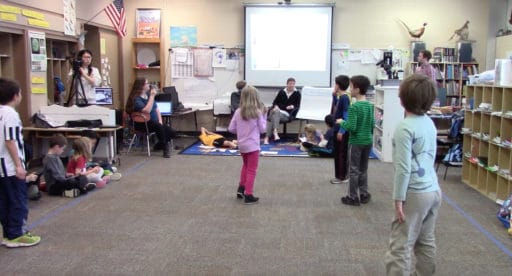The National Science Foundation-supported Interactive Science Through Technology Enhanced Play (iSTEP) project builds on the ongoing Science Through Technology Enhanced Play (STEP) project---which has been using REMAP and Open Perception's OpenPTrack as the interface between the movements of groups of elementary school students and media. iSTEP continues STEP's investigation of socio-dramatic play and learning about scientific phenomena by adding new forms of embodied engagement with … [Read more...] about Interactive Science Through Technology Enhanced Play (iSTEP)
Learning Environments
Science Through Technology Enhanced Play (STEP)
The National Science Foundation-supported Science Through Technology Enhanced Play (STEP) project is investigating how socio-dramatic play among elementary school students can help them understand scientific phenomena (e.g., the working of natural forces, complex behaviors of bees). STEP is instrumenting elementary school classrooms with REMAP and Open Perception's OpenPTrack as the interface between the students' movements and media. A collaboration with the UCLA Graduate School of Education … [Read more...] about Science Through Technology Enhanced Play (STEP)
Promoting Learning though Annotation of Embodiment (PLAE)
The National Science Foundation-supported Promoting Learning though Annotation of Embodiment (PLAE) project builds on the ongoing Science Through Technology Enhanced Play (STEP) project---which has been using REMAP and Open Perception's OpenPTrack as the interface between the movements of groups of elementary school students and media. PLAE continues STEP's investigation of socio-dramatic play and learning about scientific phenomena by adding the ability for students to use an iPad application, … [Read more...] about Promoting Learning though Annotation of Embodiment (PLAE)
SPASES: Semiotic Pivot Activity Spaces
Using computer vision, Wii remotes, RFID tags, and other sensing technologies, SPASES aimed to engage first and second graders in learning the physics of force and motion. Similar to recent work in middle schools, the project used the students' physical actions as an interface to computer simulations. Younger students are good at pretend play. It is fun, but most significantly, it contains imaginary situations and sets of rules. Like play, the physical world (and computer simulations of force … [Read more...] about SPASES: Semiotic Pivot Activity Spaces



